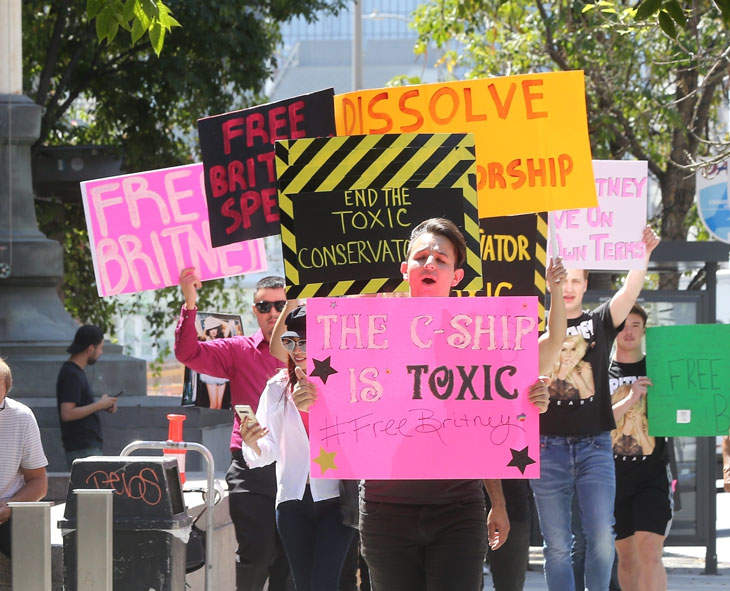
I was 10 when Britney Spears’ very first music video, “Baby One More Time,” appeared on television. A preteen, I was sharply in the generation that candy pop and boy and girl bands were targeting during their heyday in the late 1990s: Britney Spears, Christina Aguilera, the Spice Girls, the Backstreet Boys, NSYNC — an ecosystem labeled “girl music.” Girl music is bad music, music that people are ashamed to admit they love. Music where, on another note, the virginity of female singers is just as important as their artistic performance.
I was 13 in 2002, when Britney’s ex-boyfriend, Justin Timberlake, got his revenge by speaking publicly about their sex life, vilifying her in his hit single, “Cry Me a River.” At the time, it was considered perfectly acceptable to denigrate the singer, drag her through the mud. The music industry and teen magazines had already explained to me multiple times that when it came to the sexuality of famous girls, it was perfectly normal to obsess over it and make it an object of ridicule. The media’s treatment of Britney Spears is probably the most emblematic example of the sweet poison of internalized misogyny that pop culture fed to young girls coming of age in the 2000s. According to the refrain, “I love what you do, don’t you know you’re toxic …”
When the habit of contempt becomes deeply entrenched, time, and usually something shocking, is needed to take a critical look at a star and her time. Today, the #FreeBritney movement has emerged during a pandemic and claims to be about individual rights. Really? Yes, really. But in order to see that fully, we need to detox.
It requires denormalizing the paparazzi industry that ravaged Hollywood before social media, and whose omnipresence and cruelty could have cracked the most stable among us. When pictures of Britney Spears with a shaved head — pictures that drew photographers who followed her everywhere — made their way around the world in 2007, public discussion of mental health and respect for women’s private lives were not what they have become today. The idea of putting the star under a conservatorship that gave her father, James Spears, just as much control over her finances as it did over her personal decisions did not raise major questions in 2008, other than a bunch of toxic curiosity.
Today we know where that has led. Going on 13 years, James Spears has had the power to monitor and dictate his daughter’s every move. He can make her eat or not eat this or that, control her access to friends and partners, force her to take medication or undergo treatment, and limit her communication with the outside world. He can also force his daughter to work, all the while making money off of each tour or show that he forces her to do. Under the conservatorship, Britney has become, in a way, a bottomless ATM for her father. And, of course, the legal justification for this turns out to run in a vicious circle. The more the father abuses his daughter, the more she suffers, and the more her father can point to her increased suffering to justify continuing the stifling conservatorship.
We know these details because the #FreeBritney movement led by her fans has gained momentum and The New York Times’ documentary, “Framing Britney Spears,” has snowballed. Thanks to this new public pressure, the singer’s latest testimony was made public, and she finally gained the right, albeit a basic one, to choose her own lawyer to represent her in the fight to end her father’s tyrannical conservatorship.
But the contempt truly is deeply entrenched. Some are inclined to think that the situation certainly is unjust for the star, but that we have better things to do, especially this year, than worry about rich people. There again, we are mistaken.
Conservatorships (or curatorships) exist in all jurisdictions across North America, with specific provisions that apply in each state or province. These arrangements are made when a person is declared incompetent for one reason or another. The intention of these arrangements is to protect the person placed under their control. One of the effects is, inevitably, to give one or more individuals a great deal of discretionary power over someone else’s life. In some cases, the process achieves its goal. In others, it leads to abuse that can be difficult to call out, particularly when the person under conservatorship has trouble communicating, given the situation.
The Disabled Women’s Network of Canada has been saying for years that handicapped women and girls are particularly vulnerable to violence, namely sexual abuse, and those whose responsibility it is to support them commit those abuses. As DAWN spokeswoman Karine-Myrgianie Jean-Francois explained in the latest special edition of the journal “Droits et libertes,” which deals with the rights of handicapped people, “ableism is isolating.” This isolation puts a lot of handicapped people, women in particular, at risk of seeing their free will, and therefore their dignity, spoiled.
#FreeBritney thus represents much more than a hashtag in support of a miserable rich pop star. It represents a growing consciousness about the intersection of ableism and misogyny, the dangers they pose for women’s health and safety, and the need to revisit the legal mechanisms that seek, of course, to protect against harm, but in some cases, turn out to be the very sources of danger.

Leave a Reply
You must be logged in to post a comment.